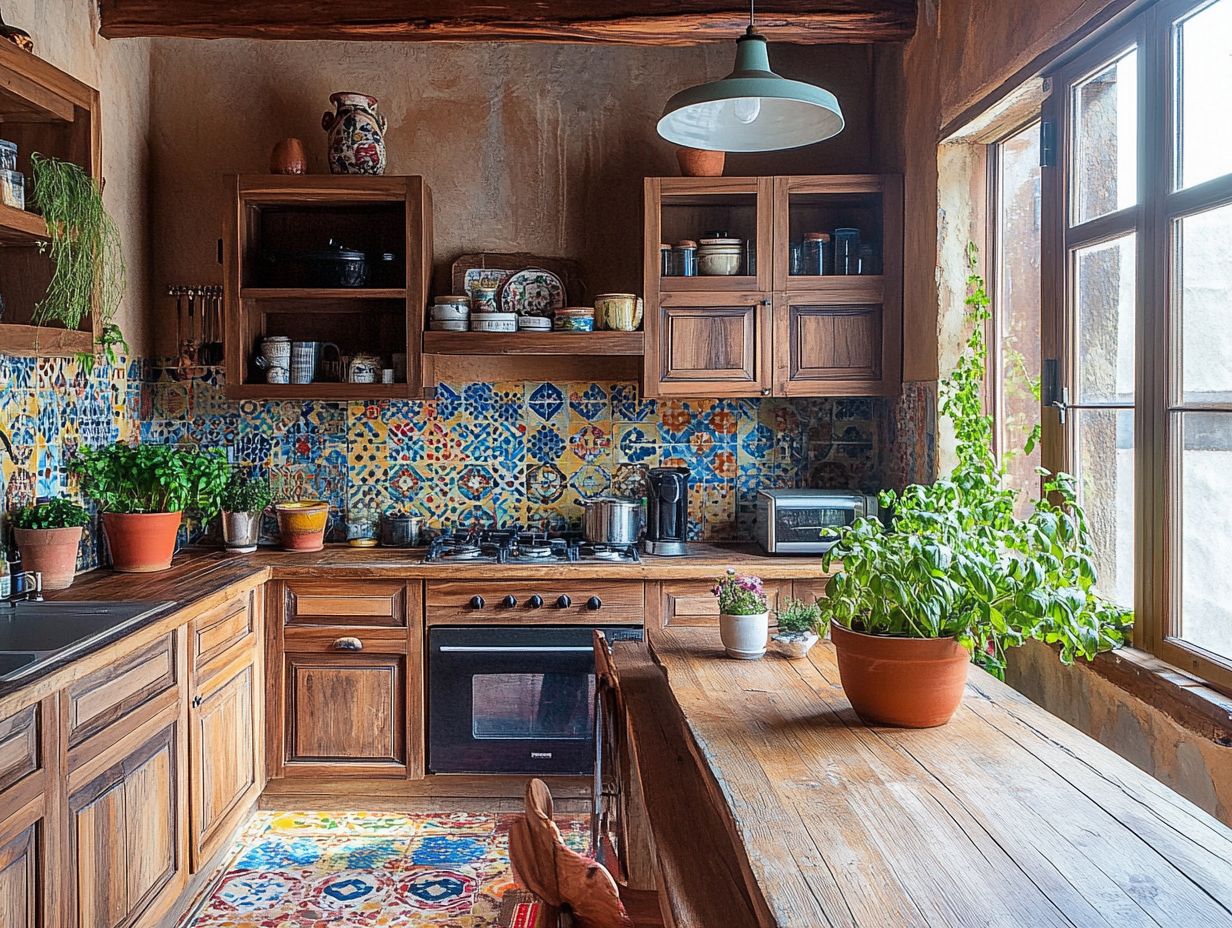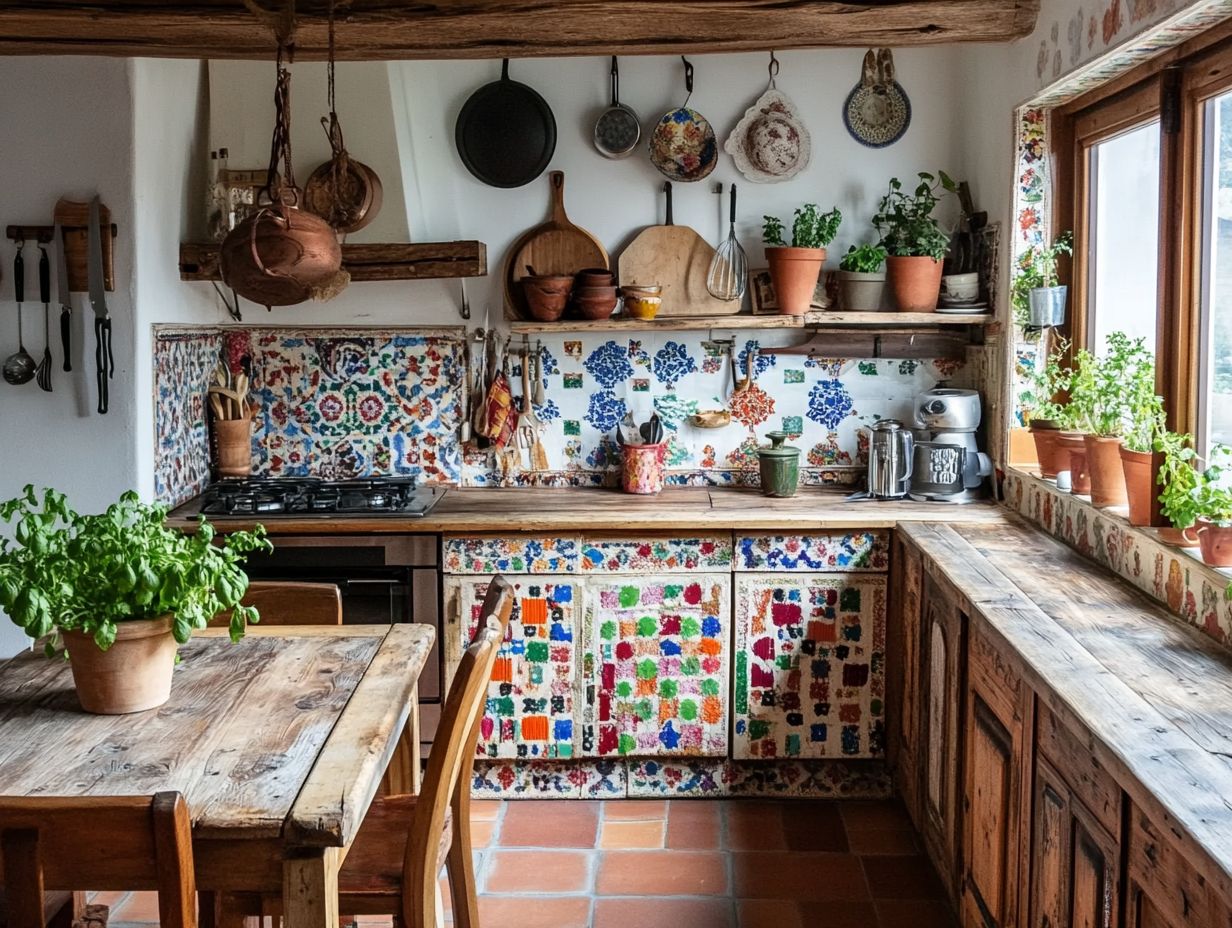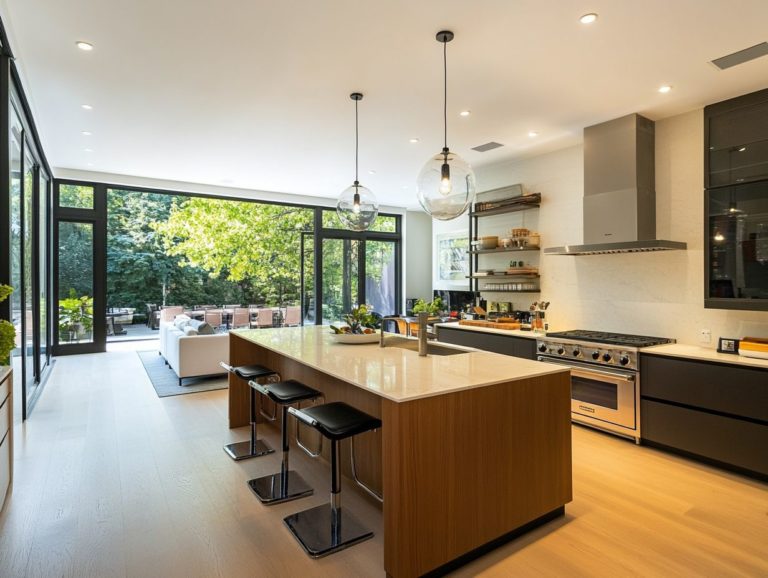Incorporating Local Materials in Kitchen Design
In today’s world, sustainability and personal expression are key. Incorporating local materials into your kitchen design enhances both functionality and beauty.
Local materials reduce your environmental impact. They also add cultural richness and unique charm to your space.
Using natural stone, reclaimed wood, or handmade tiles can transform your kitchen into a true reflection of your community and values.
Explore the benefits and inspiring examples of integrating these treasures into your home!
Contents
- Key Takeaways:
- Benefits of Using Local Materials
- Examples of Local Materials
- Handmade Tiles
- Incorporating Local Materials in Kitchen Design
- Design Considerations
- Tips for Sourcing and Incorporating Materials
- Frequently Asked Questions
- What does it mean to incorporate local materials in kitchen design?
- Why should I consider using local materials in my kitchen design?
- What are some examples of local materials for kitchen design?
- Are there disadvantages to using local materials?
- How can I find local materials for my kitchen?
- Can I use local materials if I live in an urban area?
Key Takeaways:

Using local materials in kitchen design has many benefits. It reduces environmental impact and adds cultural relevance and beauty.
Consider materials like natural stone, reclaimed wood, and handmade tiles for a sustainable kitchen.
Be mindful of the design and sourcing to achieve a cohesive and sustainable result.
What are Local Materials?
Local materials are sourced from your surroundings and are key to sustainable home design. They help cut down on transportation impacts and support your local economy.
Imagine using reclaimed wood or bamboo for cabinetry in your eco-friendly kitchen. It’s a stylish way to elevate your space and show your commitment to sustainability.
These materials are not just beautiful; they’re practical too. You can find stunning hardwood floors and countertops that work well while impressing guests.
Local materials also embody ecological mindfulness. For example, reclaimed wood often comes from old barns or factories, adding history and minimizing waste.
Bamboo is a fast-growing grass that renews quickly. Choosing these materials enhances your kitchen’s design and reduces your carbon footprint.
Consider natural stone or recycled glass for countertops. This creates a stylish and sustainable kitchen sanctuary.
Benefits of Using Local Materials
Local materials offer many advantages for your kitchen remodel. They lower your carbon footprint and support local economies.
Embracing local materials enhances your space’s charm and functionality, from countertops to flooring.
Environmental Impact
The environmental benefits of local materials are impressive. Sourcing materials nearby cuts down on carbon emissions from transportation.
Using options like reclaimed wood or bamboo makes your home better while helping the planet.
Choosing renewable resources fosters community and minimizes waste. Local materials can often be repurposed or recycled.
Also, using energy-efficient appliances boosts your sustainability efforts. This reduces energy use and lowers utility bills.
By focusing on sustainability, you create beautiful spaces that reflect eco-conscious living!
Cultural Relevance and Aesthetic Appeal

Incorporating local materials in your kitchen design holds great significance. These resources tell a story about the area’s heritage and craftsmanship.
By using materials like reclaimed wood and handmade tiles, you enhance the visual appeal and support local craftspeople. This creates a space that resonates with authenticity and responsible living.
Consider terracotta tiles, commonly found in Mediterranean regions. They add warmth and texture, symbolizing a rich culinary tradition.
Locally sourced stone countertops reflect your area’s geological uniqueness, merging functionality with a tactile connection to the land.
These materials carry the stories of the local craftspeople who crafted them. This transforms your kitchen into a vibrant testament to regional identity and sustainability.
Examples of Local Materials
Consider incorporating local materials like natural stone, reclaimed wood, and handmade tiles. Each option adds its own distinctive character to your kitchen.
Choosing sustainable materials like bamboo not only enhances elegance but also promotes eco-friendly practices in home design. These materials offer a remarkable blend of aesthetics and functionality.
They are exceptional choices for crafting a thoughtfully designed, eco-conscious kitchen.
Natural Stone
Natural stone is a timeless choice for your kitchen, offering durability and a unique aesthetic. Whether you opt for granite or quartz, natural stone countertops deliver functionality while making a bold visual statement.
This versatile material resists scratches and heat, making it ideal for meal preparation. Beyond countertops, natural stone enhances backsplashes and flooring, adding depth that echoes nature’s elegance.
With a variety of colors and patterns available, you can create a personalized space that complements other local materials like bamboo or hemp textiles. Its low maintenance and eco-friendly properties solidify its status as a top choice for blending style with sustainability.
Reclaimed Wood
Reclaimed wood elevates your kitchen’s aesthetic while embracing responsible living. This adaptable option can be used in cabinetry or flooring, adding warmth and character while minimizing environmental impact.
Incorporating reclaimed wood enhances the look of your kitchen with its rich, aged surface and unique history. This choice supports eco-friendly practices by repurposing materials that might otherwise end up in a landfill.
The diverse textures and colors in reclaimed pieces create striking focal points, whether it’s a rustic island countertop or elegant open shelving.
Reclaimed wood often proves to be more durable than newly sourced lumber, ensuring lasting quality. By integrating this material, you create a kitchen that reflects your style while championing sustainability.
Handmade Tiles

Handmade tiles add unique character to your kitchen design. They are an excellent choice for incorporating local materials.
These tiles highlight the artistry and craftsmanship involved. They also offer a stunning array of colors and styles to enhance any eco-friendly kitchen aesthetic.
Infuse your kitchen with a rich story that reflects your unique taste and regional heritage. For example, vibrant Moroccan patterns can add an exotic flair, while rustic Spanish styles evoke warmth and tradition.
These tiles are durable and easy to maintain, ensuring they beautify your space while standing the test of time.
The unique imperfections found in each tile create a one-of-a-kind visual charm. Your kitchen transforms into more than just a cooking area—it becomes a vibrant work of art.
Incorporating Local Materials in Kitchen Design
Incorporating local materials into your kitchen design requires good taste in design, functionality, and sustainability. Ensure your eco-friendly choices harmonize with your overall vision.
Whether you opt for reclaimed wood cabinetry or exquisite handmade tiles, each decision plays a vital role in creating a cohesive living space that honors local craftsmanship.
Design Considerations
When planning your kitchen design, consider the integration of sustainable materials. This creates an eco-friendly space and supports the local economy.
Think about durability and aesthetic coherence to guide your choices. Ensure your kitchen remodel truly reflects your values.
Longevity is crucial; choosing durable options means they withstand daily wear and tear while minimizing the need for replacements, which often leads to waste.
Opt for materials that harmonize with your overall design. This enhances both functionality and visual impact.
By selecting local resources, you’ll minimize transportation emissions, reinforcing your commitment to sustainability. With conscious choices, you enhance your kitchen while positively impacting your community by supporting local artisans and suppliers dedicated to sustainable practices.
Tips for Sourcing and Incorporating Materials
Sourcing local materials for your kitchen design can be a rewarding journey, allowing you to discover eco-friendly options while supporting your community.
Start by exploring local lumber yards and specialty wood suppliers. They often boast unique reclaimed wood and sustainable materials that can elevate your kitchen’s aesthetic.
Farmers’ markets and community workshops are fantastic places to uncover handcrafted items, such as wooden utensils or locally sourced tiles.
As you evaluate quality, look for certifications or labels that signify sustainable practices. This ensures your choices are visually pleasing and environmentally responsible.
When incorporating these materials, strike the right balance between aesthetics and functionality. Consider pairing a reclaimed wood countertop with a sleek, modern backsplash for a harmonious blend of styles that reflects local craftsmanship and your unique taste.
Frequently Asked Questions

What does it mean to incorporate local materials in kitchen design?
Incorporating local materials in kitchen design means using materials sourced locally for construction or renovation. This includes wood, stone, or tiles found and produced in the same region.
Ready to transform your kitchen? Start exploring local materials today!
Why should I consider using local materials in my kitchen design?
Using local materials supports nearby businesses and the community. It also reduces transportation impacts and promotes sustainability.
Local materials add a unique and authentic touch to your kitchen.
What are some examples of local materials for kitchen design?
Consider reclaimed wood, natural stone, clay tiles, and bamboo. These materials create a rustic, earthy feel and showcase regional beauty.
Are there disadvantages to using local materials?
Local materials may cost more than mass-produced options. However, the sustainability benefits and support for the local economy often make it worthwhile.
How can I find local materials for my kitchen?
Excited to find local materials? Visit markets and artisanal shops, connect with craftsmen, or research online for local suppliers.
Can I use local materials if I live in an urban area?
Absolutely! Even in urban areas, you can find local materials. Seek businesses that offer sustainable products or look for reclaimed materials from demolished buildings.





